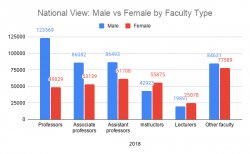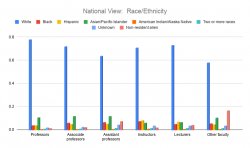Faculty involved in search committees frequently ask about the diversity of the pipeline, and how Montclair State University’s faculty demographics compare with other universities and colleges. The first imperative, following the Strategic Plan, is to resist focusing on the pipeline or comparisons; MSU has a richly diverse student population and is located in a vibrant, welcoming community, so creating and maintaining a diverse and inclusive university faculty is an attainable goal.
In recognition, however, of the frequency of these questions, a few data points have been provided below. Top-level: Faculty diversity at Montclair State University is in keeping with national trends. On a practical, action-oriented level, most useful would be to understand the demographic trends in your discipline, likely investigated and reported on by disciplinary associations and consortia of graduate education. As faculty consider priorities for faculty hiring, becoming aware of and considering the specializations that are most welcoming to diverse graduate students will be helpful to further the University’s goal of further diversifying the faculty, and through that effort, creating an inclusive educational environment for faculty and students alike.
From the National Center for Education Statistics, is the following statistical summary of U.S. college and university faculty diversity as of Fall 2016. For more information, see NCES FAST FACTS.
Two quick charts pulled from this data:


- For a detailed view of the numeric data, visit our quick figures sheet.
- For information regarding the demographics of the pipeline, see NCES Digest of Educational Statistics. Here is a link to Table 324.20 Doctor’s Degrees conferred by postsecondary institutions, by race/ethnicity and sex of student.
- For a broader understanding of the pipeline, a good article is “Do Organizational Structures and Strategies Increase Faculty Diversity” by William Tierney. Tierney provides more data on the pipeline as well as guidance on the strategies employed at universities with strong track records on diversity and inclusion.
Updated 2.17.21
